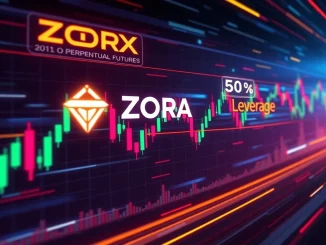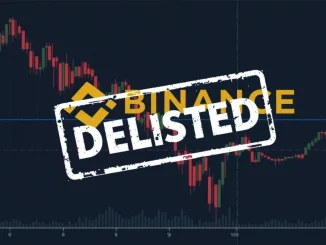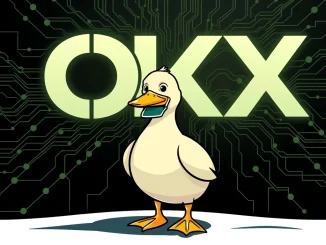
Heads up, crypto traders! In a recent announcement that has sent ripples through the digital asset community, leading crypto exchange OKX has revealed its plan to delist 11 spot trading pairs. If you’re actively trading on OKX, or simply keeping a close watch on market movements, this news is something you absolutely need to be aware of. Let’s dive into the specifics of this OKX delisting and understand what it means for you.
Breaking Down the OKX Delisting Announcement
On [current date], OKX officially announced on their website that they will be removing support for 11 spot trading pairs. This decision is set to take effect on March 20, with the delisting process occurring between 08:00 and 09:00 UTC. The specific trading pairs facing the axe are:
- XR/USDT
- GOAL/USDT
- GOAL/USDC
- KP3R/USDT
- KP3R/USDC
- LBR/USDT
- LAMB/USDT
- LAMB/USDC
- BZZ/USDT
- BZZ/USDC
- GPT/USDT
This list includes a variety of tokens paired against both USDT and USDC, indicating a broad sweep across different projects. But why is crypto exchange OKX making this move, and what are the implications?
Why Delist Spot Trading Pairs? Understanding Crypto Exchange Decisions
Cryptocurrency exchanges like OKX periodically review their listed trading pairs to ensure they meet certain standards. Delisting, while sometimes unsettling for traders holding the affected assets, is a common practice. Here are a few key reasons why an exchange might choose to delist tokens:
- Low Trading Volume: If a trading pair consistently shows low trading volume, it becomes less profitable for the exchange to maintain. Low liquidity can also lead to wider spreads and a poorer trading experience for users.
- Project Developments: Changes within the underlying projects, such as a lack of development activity, security concerns, or regulatory issues, can lead to delisting. Exchanges prioritize the safety and quality of their platform.
- Compliance Requirements: As the regulatory landscape for cryptocurrencies evolves, exchanges must adapt to meet compliance standards. Some tokens might be delisted if they no longer align with these evolving regulations in certain jurisdictions.
- Maintaining Platform Quality: Exchanges strive to offer a robust and high-quality trading environment. Delisting underperforming or problematic assets helps maintain this standard and focus resources on more active and healthy markets.
While OKX’s official announcement doesn’t explicitly state the reasons for delisting these specific 11 spot trading pairs, it’s likely a combination of these factors is at play. Traders often speculate on the exact reasons, but exchanges typically maintain a degree of discretion in these matters.
March 20 Deadline: What You Need to Do if You Hold Delisted Tokens
The crucial date to mark on your calendar is March 20. If you are currently holding any of the tokens involved in these delist tokens pairs on OKX, here’s what you need to do:
- Take Immediate Action: Don’t wait until the last minute. Begin planning your next steps as soon as possible.
- Close Open Positions: If you have any open orders in these trading pairs, make sure to close them before the delisting time frame (08:00 – 09:00 UTC on March 20). OKX will likely cancel any remaining open orders at the time of delisting, but it’s always best to be proactive.
- Withdraw Your Tokens: The most important step is to withdraw your XR, GOAL, KP3R, LBR, LAMB, BZZ, and GPT tokens from OKX. Delisting the trading pairs doesn’t necessarily mean the tokens themselves are being removed from the exchange altogether, but trading these specific pairs will no longer be possible. It’s advisable to withdraw your tokens to a personal wallet where you have full control.
- Consider Alternative Exchanges: If you still wish to trade these tokens, you’ll need to explore other crypto exchange platforms that support these trading pairs. However, always do your due diligence on any exchange you consider using, especially if you are not already familiar with it.
- Stay Informed: Keep an eye on official announcements from OKX and the projects associated with the delisted tokens for any further updates or information.
Navigating Delistings: Key Takeaways for Crypto Traders
Token delistings are a part of the crypto trading landscape. While they can be inconvenient, understanding how to navigate them is crucial for any crypto trader. Here are some key takeaways:
- Diversification is Key: Don’t put all your eggs in one basket, especially when it comes to less established or more volatile cryptocurrencies. Diversifying your portfolio across different assets and exchanges can mitigate risks associated with delistings.
- Stay Updated: Regularly check announcements and news from the exchanges you use and the projects you are invested in. Being informed allows you to react quickly to events like delistings.
- Risk Management: Understand the risks associated with trading any cryptocurrency, and implement sound risk management strategies, such as using stop-loss orders and not investing more than you can afford to lose.
- Understand Exchange Policies: Familiarize yourself with the terms of service and delisting policies of the exchanges you use. This knowledge can help you anticipate potential delistings and understand the exchange’s procedures.
In Conclusion: Act Fast and Stay Informed About OKX Delisting
The OKX delisting of 11 spot trading pairs on March 20 serves as an important reminder of the dynamic nature of the cryptocurrency market. For traders holding the affected tokens, immediate action is required to close positions and withdraw funds. Beyond this specific event, understanding the reasons behind delistings and adopting proactive risk management strategies are essential for long-term success in crypto trading. Stay informed, act decisively, and continue to navigate the exciting, yet sometimes unpredictable, world of digital assets.



